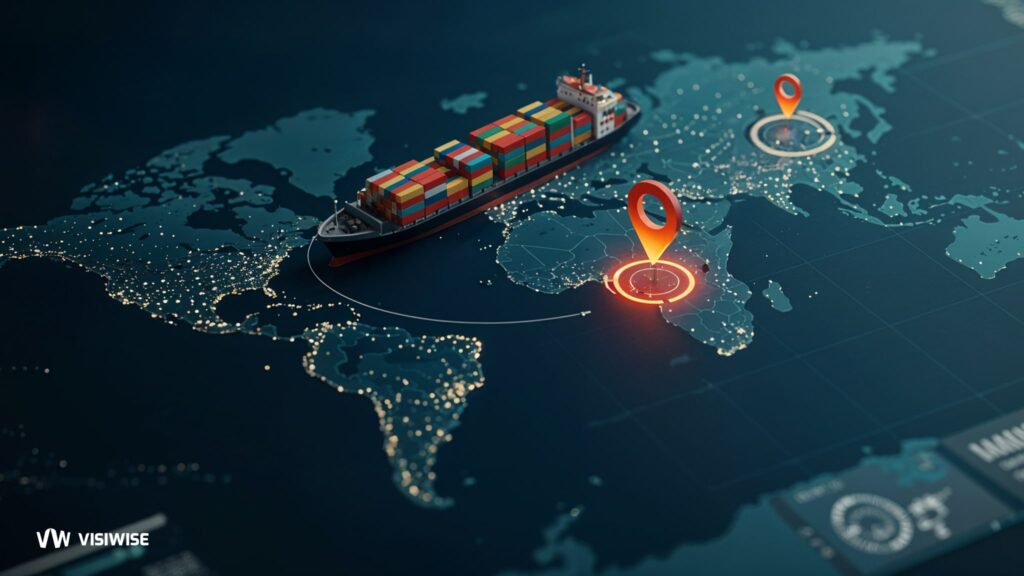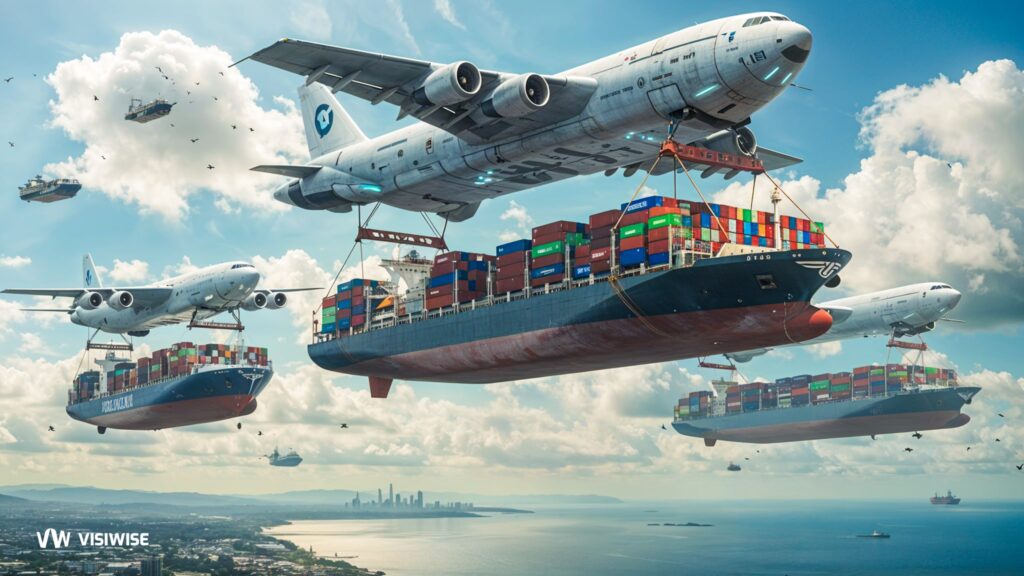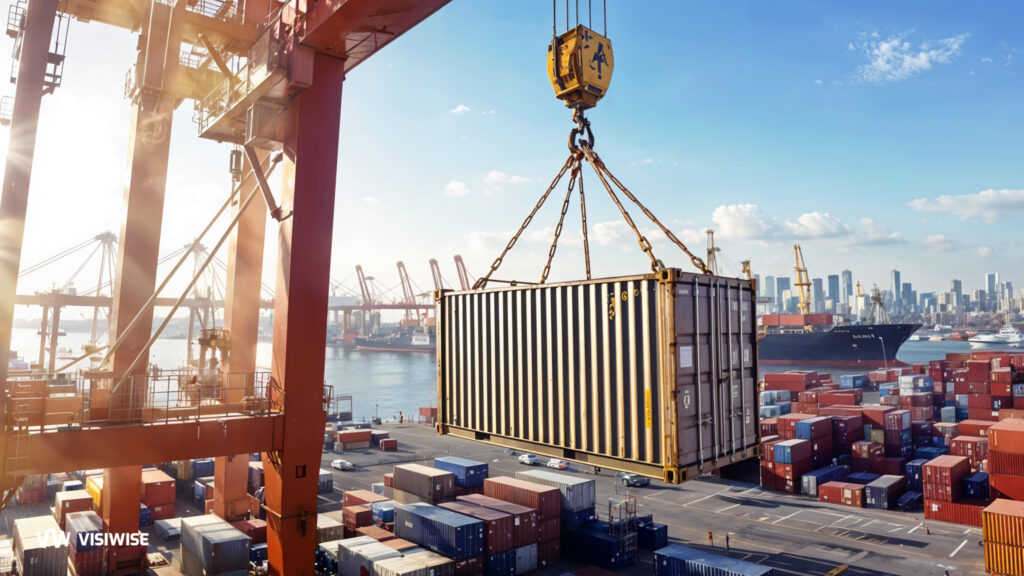Are you puzzled by unexpected detention or demurrage charges on your containers, stemming from delays in delivery or return? Are you searching for effective solutions to alleviate or even eliminate these fees?
Nevertheless, the imposition of detention and demurrage fees can be managed and even avoided altogether through the adoption of appropriate technology. Real-time visibility platforms such as Visiwise pave the way for enhanced transparency, visibility, and data-driven predictability, facilitating real-time communication among all stakeholders. This integrated solution proves beneficial for both sides, offering a mutually advantageous outcome.
Join us as we delve into insightful methods to mitigate these charges and optimize logistics operations in the following blog post.
Exploring the True Expenses of Container Shipping
When it comes to container shipping, there’s more to consider beyond the surface freight rates. Shipping lines shoulder the responsibility of providing empty containers to shippers or merchants, a process incurring production or leasing costs. These costs are integrated into the freight rate, reflecting the logistics of meeting the expanding demand for sea transportation while optimizing expenditure by ensuring efficient container turnaround.
Demurrage and Detention: Understanding the Difference
While often conflated, demurrage charges and detention fees represent distinct concepts within the realm of shipping logistics. At the core of this distinction lies the notion of time constraints: a designated period, commonly referred to as "free time," dictates the allowable duration for a full container to occupy terminal space, alongside the timeframe for returning containers and associated equipment. While definitions may vary slightly among shipping lines and ports, typically ranging from 3 to 7 days, the fundamental disparity remains constant.
Demurrage charges come into play while the container remains within the confines of the port, accruing as time elapses beyond the stipulated free period. Conversely, detention fees apply to containers situated outside the port, irrespective of their occupancy status—be it full or empty. This differentiation is crucial for navigating the intricacies of shipping logistics and understanding the financial implications associated with container movements.
Regulatory Framework for Container Detention and Demurrage Charges
While shipping lines have the autonomy to set D&D tariffs on a per-day basis, they are bound by certain regulations, ensuring a reasonable contractual free period for completing necessary formalities, cargo pickup, unloading, and container return.
Maritime regulatory bodies, like the Federal Maritime Commission (FMC) in the United States, oversee container detention and demurrage practices to prevent misuse and ensure these charges serve their intended purpose rather than solely bolstering shipping lines’ profits.
Demurrage vs. Detention Fees: A Concise Comparison
Below is a quick reference table outlining the disparities between demurrage and detention fees.
| Aspect | Demurrage | Detention Fees |
| Definition | Charges for cargo delay in port | Fees for extended container use past free time |
| Applicability | Occurs during port unloading/loading | Applies to containers held outside port area |
| Purpose | Encourages swift cargo turnover in ports | Promotes efficient container usage and return |
| Charged By | Terminal or port authorities | Shipping lines or container companies |
| Calculation Basis | Time cargo spends in port | Time containers are retained |
| Timeframe | Per day or specific time unit | Per day or specific time unit |
| Responsibility | Typically cargo owner or importer | Typically consignee or shipper |
| Waivers/Exemptions | May be waived due to port-related issues | May be waived under specific circumstances |
| Impact on Operations | Affects port congestion and cargo flow | Impacts container availability and logistics |
| Dispute Resolution | Handled between cargo owner and terminal | Resolved between shipping line and consignee |
| Documentation | Typically in bill of lading | Stated in container usage terms |
| Penalties for Non-Payment | Can lead to cargo detention or penalties | Can lead to restrictions on future bookings |
This breakdown elucidates the nuances between demurrage and detention fees, aiding in a clearer understanding of their respective roles in shipping logistics.
The Escalation of Container Detention and Demurrage Costs
Numerous factors contribute to the uptick in container detention and demurrage fees, with location playing a pivotal role. Certain areas incur higher costs due to various logistical challenges.
Terminal congestion emerges as a significant driver. Recent reports, such as Paul Berger’s coverage in the Wall Street Journal, highlight the plight of nearly 40 ships anchored near the United States’ busiest ports, Los Angeles and Long Beach. This congestion compounds as vessels await clearance to offload goods, intensifying in anticipation of the peak season rush. Customs clearance hurdles, adverse weather conditions, labor shortages, limited drayage capacity, and delays stemming from miscommunications further exacerbate the situation.
These cumulative challenges pose formidable obstacles for shippers, consignees, and freight forwarders alike, hindering their ability to adhere to the strict timeframes set by port authorities and ocean carriers. Planning shipments, predicting arrival times accurately, and coordinating timely returns become daunting tasks, often culminating in the imposition of detention and demurrage charges.
Variability in Demurrage and Detention Costs: Insights from the US Ports and Beyond
Demurrage and detention costs exhibit variability across ports and carriers. According to Container Xchange’s 2022 report, the top five most expensive ports for these charges are all in the US. Ports like New York, Long Beach, Los Angeles, Oakland, and Savannah impose fees ranging from $2,210 to $3,182 after the allotted free time for standard containers. This surge is attributed to the US-China trade dynamic, causing severe port congestion during the pandemic and subsequently leading to increased demurrage and detention charges due to container accumulation both within and outside American ports. Specialized containers, such as those for reefer, open top, out of gauge, or dangerous goods, often incur the highest demurrage and detention charges with shorter free time periods. Carrier selection significantly impacts these fees, with certain lines like Yangming, Maersk, or CMA CGM imposing higher rates resulting in substantial additional expenses for shippers.
The disparity in costs between top ports and others is significant, with the former being over 2-3 times costlier than ports like Hong Kong, Bremerhaven, and Hamburg in Europe, and at least 20 times more expensive than major Asian container hubs like Dalian in China and Busan in Korea.
The Multi-Billion Dollar Impact of Detention and Demurrage Charges
The FMC reported that between April 2020 and December 2022, the nine largest ocean carriers accumulated approximately $11.7 billion in detention and demurrage charges, highlighting the substantial financial impact on the industry. Depending on carriers, terminals, and contractual terms, demurrage charges typically range from $75 to $300 per container per day.
Strategies for Minimizing Demurrage and Detention Costs
Detention and demurrage charges can rapidly mount, reaching hundreds of dollars per container per day. Such expenses significantly erode margins and can have a detrimental effect on the cash flow and profitability of shippers, consignees, and freight forwarders alike. To mitigate or even eliminate these costs, stakeholders can implement the following strategies:
Optimize Supply Chain Planning
Enhance coordination and communication across the entire supply chain, from suppliers to distributors, by fostering stronger partnerships and implementing collaborative strategies. This involves not only improving communication between different entities but also integrating advanced planning systems that leverage predictive analytics to forecast demand accurately. By gaining deeper insights into consumer trends and market dynamics, businesses can better anticipate fluctuations in demand, enabling more proactive inventory management and reducing lead times. Moreover, streamlining procurement processes and establishing contingency plans for potential disruptions further enhance supply chain resilience. Through these concerted efforts, companies can minimize the risk of delays and disruptions, ultimately improving operational efficiency and significantly reducing detention and demurrage charges.
Improve Documentation Accuracy
Beyond ensuring completeness and accuracy in paperwork, companies should invest in digital documentation systems that streamline the documentation process and reduce the likelihood of errors. Implementing electronic documentation not only expedites customs clearance but also provides real-time visibility into shipment status, enabling proactive measures to prevent delays. By improving documentation accuracy, companies can minimize the occurrence of delays caused by administrative errors, thus reducing detention and demurrage charges.
Utilize Container Tracking Technologies
Container tracking stands as a pivotal factor in diminishing demurrage and detention costs. The integration of various tracking technologies via a unified visibility platform elevates the efficacy of container monitoring. Cutting-edge technologies like GPS tracking and RFID tagging furnish real-time insights into container whereabouts and conditions. By harnessing these integrated solutions, businesses gain the capability to monitor container journeys across the supply chain, identifying potential bottlenecks or delays in advance. Moreover, container tracking systems facilitate proactive communication with carriers and terminals, empowering timely interventions to avert detention and demurrage charges. This seamless coordination engendered by advanced tracking technologies not only optimizes operational efficiency but also mitigates financial losses stemming from avoidable delays.
Negotiate Favorable Terms
In addition to negotiating extended free time or reduced rates with carriers and terminals, companies can explore alternative contractual arrangements that incentivize efficient cargo handling. For example, implementing performance-based contracts that reward carriers and terminals for timely container turnover can help minimize detention and demurrage charges. By negotiating favorable terms and aligning incentives with key stakeholders, companies can mitigate the financial impact of detention and demurrage charges.
Prioritize Efficient Cargo Handling
Streamlining loading and unloading processes involves not only optimizing terminal operations but also improving coordination between different parties involved in cargo handling. This may include implementing standardized processes, investing in equipment automation, and providing training for terminal staff. By prioritizing efficient cargo handling, companies can minimize dwell times at terminals and reduce the risk of detention and demurrage charges.
Invest in Predictive Analytics
Beyond forecasting container demand, predictive analytics can also be used to identify potential bottlenecks or disruptions in the supply chain. By analyzing historical data and identifying patterns, companies can proactively allocate resources and adjust operations to mitigate the risk of delays. Additionally, predictive analytics can help optimize inventory levels and transportation routes, further reducing the likelihood of detention and demurrage charges.
Enhance Communication Channels
Establishing clear lines of communication involves not only improving communication between internal departments but also fostering collaboration with external partners, such as carriers and terminals. This may include implementing digital communication platforms, such as collaborative supply chain portals, that enable real-time communication and information sharing. By enhancing communication channels, companies can quickly address issues as they arise and prevent misunderstandings that may lead to detention and demurrage charges.
Implement Container Pooling
Exploring options for container sharing or pooling involves collaborating with other companies or industry partners to optimize container utilization. This may include establishing container sharing agreements, participating in industry-wide pooling programs, or leveraging third-party logistics providers that specialize in container pooling services. By sharing containers among multiple shipments, companies can reduce idle time and minimize the risk of detention and demurrage charges.
Monitor Industry Trends
Staying informed about industry trends and regulatory changes involves actively monitoring developments in the global logistics landscape. This may include tracking changes in trade policies, port operations, and carrier practices that may impact detention and demurrage charges. By staying ahead of industry trends, companies can adapt their strategies and processes accordingly, minimizing the risk of financial losses due to detention and demurrage charges.
Collaborate with Service Providers
Working closely with carriers, terminals, and other service providers involves fostering collaborative relationships based on mutual trust and transparency. This may include regular meetings to review performance metrics, identify areas for improvement, and implement joint initiatives to reduce detention and demurrage charges. By collaborating with service providers, companies can leverage their expertise and resources to implement effective solutions that address detention and demurrage challenges proactively.
Final Thoughts
In conclusion, the effective utilization of container tracking, alongside innovative solutions like the Visiwise real-time visibility platform, significantly reduces the costs associated with demurrage and detention. By harnessing the power of real-time visibility provided by container tracking systems and Visiwise, stakeholders can proactively manage container movements, anticipate potential delays, and take timely action to prevent them. Moreover, streamlined operations, enhanced communication, and optimized processes further contribute to mitigating detention and demurrage charges. Through collaborative efforts and the adoption of cutting-edge technologies, such as Visiwise, the shipping industry can navigate challenges more efficiently, ultimately minimizing costs and maximizing profitability for all involved parties.


